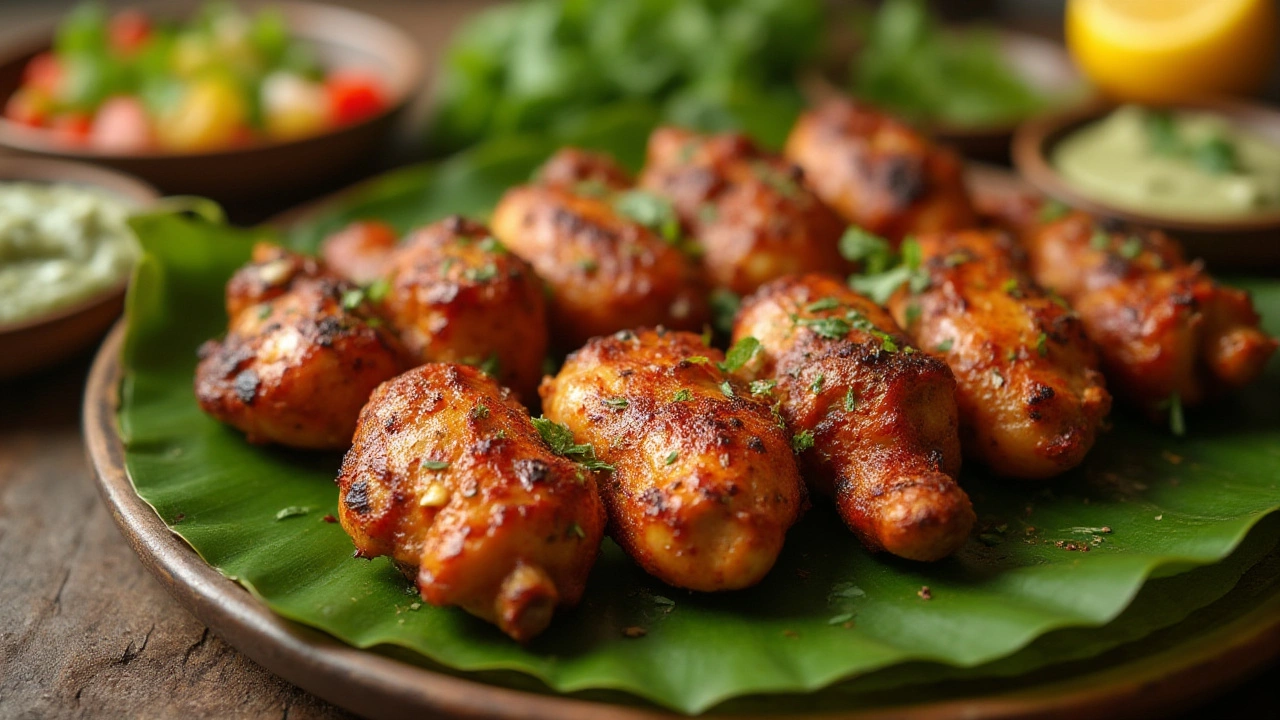Bite into the fiery red crust, and you’ll never forget it. The smoky flavor from the tandoor, the explosion of spices, that juicy meat underneath—it’s no surprise tandoori chicken has fans all over the globe. But once the craving settles, this little thought creeps in: is tandoori chicken actually good for you, or is it just another guilty pleasure hiding behind a health halo?
What’s Really in Your Tandoori Chicken?
First, let’s dismantle the myth that all brightly colored food is loaded with artificial stuff. Traditionally, tandoori chicken owes its signature hue to Kashmiri chili powder and a dash of turmeric, not red dye. Sure, some restaurants now cheat with food coloring, but if you make it at home or choose your spots wisely, you avoid the fake stuff entirely.
It helps to look at what goes into the marinade. Yogurt forms the base, tenderizing the chicken and packing in probiotics. Spices like cumin, coriander, garam masala, garlic, and ginger do more than bring heat—they also add antioxidants and anti-inflammatory benefits. Chicken itself is a lean protein, with one leg piece (cooked) providing about 13-15 grams of protein, but only about 150 calories if most of the skin and visible fat are trimmed away.
Here’s a quick look at the basic nutrition in a standard portion of tandoori chicken (when prepared in a traditional clay oven, called a tandoor, and not deep-fried or soaked in ghee):
| Per 100g (about 1 drumstick, no skin) | Value |
|---|---|
| Calories | 140-160 kcal |
| Protein | 14-18 g |
| Fat | 6-8 g |
| Carbohydrates | 2-3 g |
| Sugar | 1 g |
| Sodium | 350-600 mg (varies) |
Keeping the skin on or adding butter before serving will bump the calories and fat higher. But the method of cooking makes a huge difference. Grilling in a tandoor lets extra fat drip away, so you dodge greasy calories you’d get from frying.
But, does it always stay healthy? That can depend on how the chicken is marinated. If there’s a shortcut with pre-made spice mixes, watch for extra salt and MSG. Excess salt is linked to high blood pressure. Homemade is always better, since you control the salt and oils.
The biggest flavorful trick is time. Give your chicken several hours, ideally overnight, in the fridge so the yogurt and spices soak in fully. Don’t be stingy with lemon juice, either—it not only lifts flavors but helps cut down on sodium by piquing your taste buds with acidity.

Balancing Benefits and Risks: The Good and Not-So-Great
Tandoori chicken often pops up on lists of “Best Healthy Indian Foods,” and for good reason. Unlike curries swimming in heavy cream or deep-fried finger foods, tandoori chicken is light, high in protein, and packs big flavor without a calorie overload. An Indian-American nutrition research from 2023 spotted that people who swapped fried takeouts with home-grilled tandoori chicken three times a week shaved off about 460 calories per week, just from that single change. Not earth-shattering, but over months, it adds up.
Still, no food is perfect. Excessive char can form when chicken is cooked on super high heat, especially over open flames; this blackened crust can build up compounds called PAHs (polycyclic aromatic hydrocarbons) and HCAs (heterocyclic amines), both of which are hot topics in cancer research. Foods cooked in a traditional tandoor don’t usually pose big risks, since the high heat is distributed evenly and marinades offer some protection, but it’s smart not to seek out the blackest, crunchiest bits all the time.
Your sodium intake could also creep up if you’re generous with the salt or using store-bought marinades. Check nutrition labels on packet mixes; some run as high as 800 mg of sodium per serving—almost a third of the daily limit recommended by the American Heart Association. Too much sodium raises the risk of high blood pressure, heart disease, and stroke down the line.
What about the “red” reputation? Some restaurants improve visual appeal by adding food coloring—Red 40 is allowed in small amounts, but studies have flagged possible behavioral and allergic issues, especially in children. If you’re unsure about your local takeaway, just ask, or better yet, ask for “no artificial colors.”
Let’s not forget about the accompaniments: Butter-soaked naan, creamy dips, or mountains of rice can shift the meal from light-and-fit to a calorie bomb. To keep it wholesome, load your plate with grilled veggies, a bowl of lemony raita, or a side salad. It satisfies and gives a fiber boost to balance the protein punch.
- If you have high cholesterol, opt for chicken breasts and skip the skin.
- Sensitive to spice? Go lighter on chili powder and garam masala; add more ginger and garlic for mellow warmth.
- Pair it with whole-grain sides or leafy greens, not just carbs.
- Use Greek yogurt in the marinade for extra protein and less fat.
- Not into meat? Try tandoori-style tofu or cauliflower for a plant-based take.
When you balance out the extra risks (salt, char, coloring) with smart choices and skip the heavy sides, tandoori chicken lands firmly in the “good” zone for most people watching calories or protein intake. And it keeps taste-buds truly satisfied, which counts for more than people admit.

Best Practices: Enjoying Tandoori Chicken the Healthy Way
Here’s where personal kitchen magic comes in: making tandoori chicken at home isn’t just about taste—it’s a chance to keep every ingredient in check. You get to skip questionable colors, control the oil, and scale spices to your liking and tolerance.
Start with good-quality chicken (free-range or organic if you can, lean breast or thigh). Slash the surface with a knife several times before marinating, so flavors dive deep. For marinade, blend thick plain yogurt (Greek, if you want more protein), ginger-garlic paste, lemon or lime juice, a generous sprinkle of smoked paprika, cumin, coriander, garam masala, turmeric, and chopped green chili if you want a real kick. Leave out food color; use extra paprika or Kashmiri chili for the deep red tone.
Let it sit in the fridge as long as you can. Overnight is best. This patience does more than boost taste—studies have found that long marination with yogurt lowers the eventual formation of HCAs during grilling, acting like a little “shield” against those unhealthy compounds.
No tandoor? No problem. Crank your oven as high as it’ll go (usually 250°C or more) and use a wire rack so excess fat drips below. Or try it on a barbecue for the same smoky effect—just don’t let flames lick the meat and turn it pitch black. Brush off any burnt spots before serving.
Lemon wedges and raw onions make the best (and lowest-cal) classic Indian sides. If you’re serving others, plate up with mint coriander chutney—the fresh herbs balance the earthy spice beautifully, and it’s loaded with vitamin C.
Worried about sodium? Experiment with no-salt seasoning blends, or use more sour agents (like amchur powder or extra lemon juice) for pop without the pressure. A sprinkle of pomegranate seeds makes it feel fancy and brings extra antioxidants to the plate.
For meal-prep fans, grilled tandoori chicken keeps in the fridge for up to three days and works cold in salads, wraps, or with a side of quinoa. It also freezes well for a speedy weeknight fix. Just don’t microwave from frozen—maintain that juicy texture by reheating gently in the oven.
- Keep the flames off the meat—cook with indirect heat when grilling.
- Make your own spice blends for full flavor minus preservatives.
- Ask restaurants to hold the food coloring and less salt, or just make your own at home.
- Go big on veggies to fill you up and add crunch—bell peppers, onions, and zucchini work perfectly.
- If someone asks for extra moist chicken, brush with a tiny dab of olive oil, not butter or ghee.
Nothing about tandoori chicken is written in stone. As long as you stay mindful of the extras—oils, color, salt—you keep all the bold taste and health wins without sacrificing a thing. So yes, tandoori chicken can be very good, especially when you’re the one handling the spices. Don’t be afraid of its color or sizzle; just make it your own, and enjoy every juicy bite.
